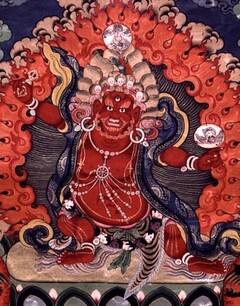Takhyung Barwa Empowerment
འུྃཿ བླ་མ་དྲག་པོ་རྟ་ཁྱུང་འབར་བ་ལས༔ དབང་དང་བསྙེན་པའི་གནད་ཡིག༔
Key Points for the Empowerment and Approach Practice of Takhyung Barwa, ‘The Blazing Wrathful Guru, Hayagrīva and Garuḍa’
by Jigme Lingpa
Crucial Points of the Empowerment1
དྲག་པོ་རྟ་ཁྱུང་འབར་བ་ཡི༔
དབང་དང་བསྙེན་པའི་གནད་ཡིག་ནི༔
ཚོམ་བུའི་སྟེང་དུ་དཔལ་གཏོར་བཀོད༔
ཙཀླི་བཙུགས་ལ་སྨན་གཏོར་དང་༔
ཆོས་སྲུང་སྔོན་གཏོར་བཅས་པ་བཤམ༔
བདག་མདུན་རོ་གཅིག་བསྐྱེད་བཟླས་བྱ༔
ལས་བུམ་བསྒྲུབ་ཅིང་སློབ་མ་བཀྲུ༔
བགེགས་བསྐྲད་བསྲུང་འཁོར་བསྒོམས་པའི་རྗེས༔
དཀོན་མཆོག་གསུམ་ལ་བདག་སྐྱབས་མཆི༔
For the Key Points for the Empowerment and Approach Practice
For The Blazing Wrathful Guru, Hayagrīva and Garuḍa, do as follows:
On top of the heap representing the maṇḍala, set up a ‘pal tor’ (glorious torma),
With an empowerment card2 inserted in it, arrange a ‘men tor’,
Along with a ‘preliminary torma’ for the guardians of the Dharma.
While considering the self and front visualizations to be identical, generate the visualization and recite the mantra.
Consecrate the activity vase and purify the disciples.
Banish the obstructers, meditate on the protective sphere,
And then, beginning with “I take refuge in the Three Jewels…”,
དཀོན་མཆོག་གསུམ་ལ་བདག་སྐྱབས་མཆི། །
könchok sum la dak kyab chi
I take refuge in the Three Jewels,
སྡིག་པ་མི་དགེ་སོ་སོར་བཤགས། །
dikpa mi gé sosor shak
Confess all my wrongdoing and non-virtuous actions,
འགྲོ་བའི་དགེ་ལ་རྗེས་ཡི་རང་། །
drowé gé la jé yi rang
Rejoice in the virtues of beings,
སངས་རྒྱས་བྱང་ཆུབ་ཡིད་ཀྱིས་གཟུང་། །
sangye changchub yi kyi zung
And maintain the mind of awakening to buddhahood.
སངས་རྒྱས་ཆོས་དང་ཚོགས་མཆོག་ལ། །
sangye chö dang tsok chok la
I take refuge in the Buddha, the Dharma and the Supreme Assembly
བྱང་ཆུབ་བར་དུ་སྐྱབས་སུ་མཆི། །
changchub bardu kyab su chi
Until I reach enlightenment.
རང་གཞན་དོན་གཉིས་རབ་བསྒྲུབ་ཕྱིར། །
rangzhen dön nyi rab drub chir
To fully accomplish the benefit of myself and others
བྱང་ཆུབ་སེམས་ནི་བསྐྱེད་པར་བགྱི། །
changchub sem ni kyepar gyi
I will arouse the heart of the awakening.
བྱང་ཆུབ་མཆོག་གི་སེམས་ནི་བསྐྱེད་བགྱིས་ནས། །
changchub chok gi sem ni kyé gyi né
Having aroused the supreme heart of awakening,
སེམས་ཅན་ཐམས་ཅད་བདག་གིས་མགྲོན་དུ་གཉེར། །
semchen tamché dak gi drön du nyer
I will honour all beings as my guests
བྱང་ཆུབ་སྤྱོད་མཆོག་ཡིད་འོང་སྤྱད་པར་བགྱི། །
changchub chö chok yi ong chepar gyi
And uphold the supreme awakened conduct, pleasing to all.
འགྲོ་ལ་ཕན་ཕྱིར་སངས་རྒྱས་འགྲུབ་པར་ཤོག །
dro la pen chir sangye drubpar shok
For the benefit of beings, I will accomplish buddhahood.
སོགས་ཀྱི་རྒྱུན་བཤགས་སྡོམ་བཟུང་རྗེས༔
སློབ་མ་ལྷར་བསྐྱེད་ཡེ་ཤེས་དབབ༔
ཏིཥྛ་བཛྲས་བརྟན་པར་བྱ༔
Recite the daily confession and the vows,
Following that, let the wisdom blessings descend on the disciples, visualizing themselves as the deity,
And, with tiṣṭha vajra, make it secure and firm.
གཏོར་མ་ལྷར་བསྐྱེད་སྤྱི་བོར་བཞག༔
Place the torma, which is visualized as the deity, on the crown of their heads, and recite the verses beginning:
ཨོ་རྒྱན་ཡུལ་གྱི་ནུབ་བྱང་མཚམས༔
orgyen yul gyi nubjang tsam
In the north-west of the land of Oḍḍiyāna…
སོགས་གྱི་མཐར༔
Culminating with:
ལུས་ལ་སྐུ་ཡིས་བྱིན་གྱིས་རློབས༔
lü la ku yi jingyi lob
Your body receives the blessing of the enlightened body,
སྐུ་ཡི་དངོས་གྲུབ་ཐོབ་པར་ཤོག༔
ku yi ngödrub tobpar shok
May you obtain the siddhi of enlightened body.
རྩ་སྔགས་མཐར་
At the end of the root mantra, add:
ཀཱ་ཡ་ཨ་བྷི་ཥིཉྩ་ཨོཾ༔
kaya abhikintsa om
kayābhiṣiñca oṃ
དེ་བཞིན་དུ་མགྲིན་པར་བཞག་ལཿ
Likewise, touching their throat with the torma, recite:
ངག་ལ་གསུང་གིས་བྱིན་གྱིས་རློབས༔
ngak la sung gi jingyi lob
Your speech receives the blessing of the enlightened speech,
གསུང་གི་དངོས་གྲུབ་ཐོབ་པར་ཤོག༔
sung gi ngödrub tobpar shok
May you obtain the siddhi of enlightened speech.
རྩ་སྔགས་མཐར༔
At the end of the root mantra, add:
ཝཱཀྐ་ཨ་བྷི་ཥིཉྩ་ཨཱ༔
waka abhikintsa ah
vākābhiṣiñca āḥ
སྙིང་གར་བཞག་ལ༔
Then, touching their heart with the torma, recite:
ཡིད་ལ་ཐུགས་ཀྱིས་བྱིན་གྱིས་རློབས༔
yi la tuk kyi jingyi lob
Your mind receives the blessing of the enlightened mind,
ཐུགས་ཀྱི་དངོས་གྲུབ་ཐོབ་པར་ཤོག༔
tuk kyi ngödrub tobpar shok
May you obtain the siddhi of enlightened mind.
རྩ་སྔགས་མཐར༔
At the end of the root mantra, add:
ཙིཏྟ་ཨ་བྷི་ཥཱིཉྩ་ཧཱུྃ༔
tsitta abhikintsa hung
cittābhiṣiñca hūṃ
གཏོར་མ་འོད་ཞུ་སློབ་མར་བསྟིམ༔
The torma melts into light, and dissolves into the students.
བཟླས་ལུང་སྦྱིན་ཞིང་དམ་ཚིག་བསྒྲག༔
The transmission for recitation is given, and the samaya made clear.
བྱིན་བརླབས་དབང་གི་རིམ་པའོ༔
These are the stages of the empowerment through blessing.
ས་མ་ཡ༔ རྒྱ་རྒྱ་རྒྱ༔
Samaya! Gya Gya Gya.
| Rigpa Translations, 2022. Edited for Lotsawa House by the Longchen Nyingtik Project, 2023.
Source:
'Jigs med gling pa. "bla ma drag po rta khyung 'bar ba las/ dbang dang bsnyen pa'i gnad yig", in klong chen snying thig rtsa pod. 5 Vols. Bodhnath, Kathmandu and Bodhgaya, Bihar: Shechen Publications, 1994. (BDRC W1KG13585). Vol. 2: 439–441.
Version: 1.0-20230207
